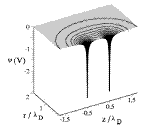Electrical and Computer Engineering, Department of

P. F. (Paul Frazer) Williams Publications
Document Type
Article
Date of this Version
June 1985
Abstract
We have extended the Kobayashi, Sankey, and Dow [Phys. Rev. B 25,6367 (1982)] theory of deep levels in Hg1-xCdxTe to include (vacancy, impurity) nearest-neighbor pairs. In qualitative agreement with the results obtained by these workers for isolated point defects, we find that the composition dependences (dE /dx) of the defect energy levels associated with such complexes depend on the site occupied by the impurity atom. Furthermore, we find that the composition dependences of some of the defect levels produced by such a complex are very different than the dE /dx of levels associated with the corresponding isolated point defects. We thus suggest that this theory can often be used as an aid in the identification of the defect center producing an observed energy level. In particular, it can be used to obtain site information about an observed level and, in favorable cases, to distinguish between levels produced by isolated point defects and those produced by complexes. As an example, we compare our theoretical predictions for the dE /dx of levels associated with (vacancy, impurity) pairs to the experimental slopes of the energy levels observed in deep level transient spectroscopy by Jones, Nair, and Polla [Appl. Phys. Lett. 39,248 (1981)] and find that the theory lends support to these workers' interpretation of their data. In addition, we present new photoluminescence data on both a previously observed and identified acceptor and on an unknown center in Hg 1-xCdxTe. As a further example of the usefulness of our theory, we compare the theoretical slopes of energy levels associated with (vacancy, impurity) pairs with the composition dependences of the defect levels extracted from the photoluminescence data. The results of both of the theoretical-experimental comparisons show that the theory can be used successfully, in conjunction with experimental data, to aid in the identification of the defect center which produces an observed energy level.


Comments
Published in J. Appl. Phys. 57 (12), 15 June 1985. Copyright © 1985 American Institute of Physics. Used by permission.